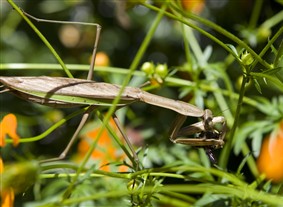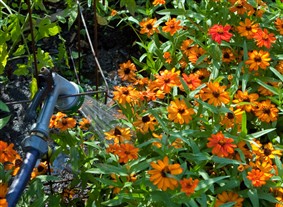Welcome Praying Mantises
Views: 4832

The other day, I was strolling through a private garden in Raleigh, North Carolina with a bunch of other plant fanatics. Then a couple frantically, but quietly, motioned me close to a large shrub. They seemed to be peering into the depths of the plant.
We were on a special private tour with the Garden Writers of America during their annual symposium. About sixty of us descended into a large residential garden to snap photos and admire the spectacular shrub and perennial borders. Nestled in among the leaves was a praying mantis enjoying his afternoon snack.
Praying Mantises in the Garden
This was one time I wish I had a small video camera with me. It was a fascinating event to watch. First the jointed insect rotated its triangular head. It watched me for a while and then went back to his meal. He intently devoured a large fuzzy bumblebee that was locked in his folded legs.
So what does a carnivorous praying mantis have to do with kitchen gardens? Everything. It has everything to do with kitchen gardens. I once heard that praying mantises are an indicator of a healthy garden—if they live in your garden, it’s a good thing. It means you have the diversity to support them.
Praying mantises will eat many insects, including the beneficial ones in your garden; they don’t make a distinction. They have been known to eat hummingbirds. But they eat the bad bugs, too. You can purchase praying mantis eggs to hatch and then release into your garden as part of a biological pest control plan.
Attracting Beneficial Insects
One of the most exciting things for me as a landscape architect who designs edible and useful seasonal gardens is the idea of incorporating kitchen gardens into the entire garden.
The kitchen garden or potager should not be isolated in the remote parts of the yard devoid of other flowers and shrubs. Rather, it should be integrated with flowering shrubs, grasses, herbs, and perennials.
The goal is to have something in bloom to attract beneficial insects, birds and butterflies throughout the seasons. It’s most effective when these nectar producers are planted right outside the formal potager or integrated with the edibles.
Take a close look at your garden. Fall is a great time to spot praying mantises, walking sticks, and spiders.
Meet Jennifer Bartley
Jennifer Bartley grew up on a ravine near an ancient Indian mound. She remembers spending glorious childhood days picking wildflowers and playing in an old,…
Jennifer's Recent Posts

Hand Watering the Kitchen Garden








